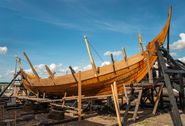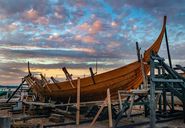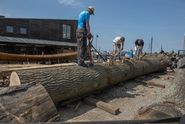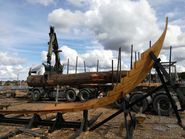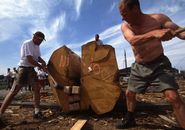
Skuldelev 3 Revisited
In 1962, the remains of five Viking Age ships were excavated near Skuldelev on Roskilde Fjord. The five Skuldelev ships were a unique and invaluable archaeological find as they represented each of the main vessel types that typified Viking Age seafaring: a large ocean-going trading vessel, two warships and two smaller coastal transport/fishing vessels. Over the next years, the five ships were documented, conserved and reconstructed for exhibition in the newly-built Viking Ship Hall. The ships were so well preserved, that the idea of building 1:1 sailing reconstructions of all five of the Skuldelev ships quickly arose.
The archaeological experiment began
In 1982, twenty years after the excavation, the Viking Ship Museum began building its first Viking ship reconstruction. They chose the best preserved of the five ships to start with: the 14 m long coastal transport and trading vessel, Skuldelev 3. Over the next two years, a group of volunteers built Roar Ege at the Museum boatyard. The Roar Ege Project marked the start a process that would form the core of the Museum’s research endeavours: the experimental archaeological reconstruction of archaeological ship and boat finds.
Roar Ege was launched in 1984 and the seaborne part of the archaeological experiment could begin. A volunteer boat guild was established and systematic sailing and rowing tests were carried out to determine the ship’s sailing abilities.
These tests – and the reconstruction process that went before it – drew on the combined expertise of many different specialists, including sailors, boatbuilders and archaeologists and revolutionised our understanding of how Viking ships perform on the water. Where once they were seen as quite primitive and assumed top have poor sailing capabilities, the experiences gained with Roar Ege proved quite the opposite.
Roar Ege enters into retirement
After more than 30 years on the water, Roar Ege had many sea miles under its keel, including voyages to Gotland, Poland and France, as well as countless days on the seas around Denmark. The years had, however, taken their toll on the ship. Roar Ege had undergone several major phases of repair – most recently in 2014 when the stringer, many of the iron rivets and sections of the planking material were replaced. It was hoped this repair would keep Roar Ege in action for several more years but by spring 2016, the hull had deteriorated to such an extent that it was clear Roar Ege’s sailing days were over.
Interestingly, it’s not the oak in the hull that’s turned out to be the weak point.
Rather, it’s the iron rivets that hold the clinker-laid planking material together. The rivets have rusted and expanded to such a degree, that they have led to numerous cracks in the hull’s planking, causing the ship to leak.
To continue repairing the damage would have meant breaking with the terms of the archaeological experiment: the Vikings would most likely have stripped the ship of any timbers that could be reused and scrapped the rest. So in 2016, 32 years after Roar Ege was launched, the Museum’s first reconstructed Viking ship was retired permanently on land.
We are now in the process of studying the hull, in order to gain a thorough understanding of the processes of age and decay. This data will then be used to draw initial conclusions concerning the potential lifespan of the Museum’s other reconstructed Viking ships, as well as shedding light on the longevity of ships in the past.
Roar Ege may have entered into retirement but the programme of experimental archaeological research continues.
Skuldelev 3 Revisited
Since the reconstruction of the Skuldelev ships began over 30 years ago, it has been a fixed principle for the Museum that the Skuldelev ships are best understood when we have a full-scale, sailing reconstruction of each of them. To that end, in 2017 we began work on our second reconstruction of Skuldelev 3 and a new project – Skuldelev 3 Revisted – began.
This reconstruction is not, however, an exact copy of Roar Ege. The experimental archaeological methods practised at the Museum have been greatly refined in the years since the construction of Roar Ege began. We can now look at the original ship find from a completely different perspective: one of many years collective experience in the interpretation and reconstruction of archaeological ships, with all the insight and inherent understanding that affords.
The reconstruction process began therefore from scratch, starting with a re-examination of the surviving timbers of Skuldelev 3 as well as the 1:1 documentation carried out at the time of its excavation. A new 1:10 scale-model was produced, which formed the basis for the full-scale reconstruction.
The full-scale reconstruction process took place at the Museum boatyard from 2017 – 2022 and the new reconstruction, Estrid Byrding, was launched on May 7th, 2022.
Here on the project website, you can see photos and film from the build and learn more about the original ship-find. Over the coming weeks, we will begin working on Estrid’s rigging and aim to have the ship rigged up and ready to sail by August. You can follow the process live at the boatyard and online via Facebook and Instagram.
Latest news from the Skuldelev 3 project:
Launch of a new Viking ship May 7th 2022
Come and join us for a day of celebration at the Viking Ship Museum boatyard on Saturday May 7th.
Launch of a new Viking ship May 7th 2022
The new reconstruction of Skuldelev 3 has already provided many new insights on Viking Age boatbuilding during the…
Launch of a new Viking ship May 7th 2022
The new reconstruction of Skuldelev 3 has already provided many new insights on Viking Age boatbuilding during the…
The Vikings used iron rivets and roves when they build their ships.
The Vikings used iron rivets and roves when they build their ships. But in the construction of the Skuldelev 3…
Cleaving day at the boatyard
The massive 12 meter long oak log has been cleaved into to halves, but the work doesn't stop there.The boatbuilders…
200 year-old-oak to be cleaved at the Viking Ship Museum.
The massive 8 meter long oak log, with a weight of around 8 tons, will be cleaved with mallets, wedges and raw…
Delivery of massive oak logs to the Viking Ship Museum’s boatyard
Two 200-year-old oak logs – one of which weighs over 6 tons – will arrive at the Viking Ship Museum’s boatyard on…
You can also get regular updates from the project on the Museum’s Instagram profile
» Visit us on Instagram...
See regular photo and film updates on Facebook
» Visit us on Facebook...















